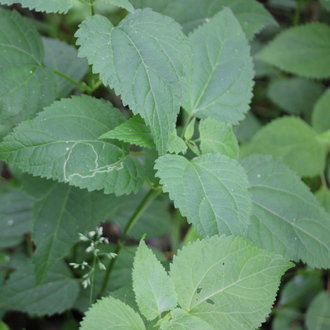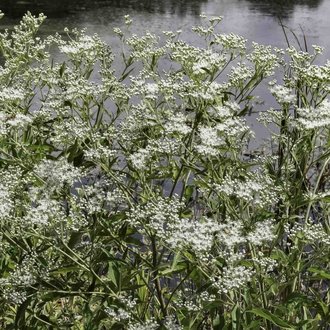White Snakeroot vs Late Boneset
These closely-related plants can be tricky to distinguish, especially early in the season, before they bloom. Although they have some overlap in habitat, late boneset ranges farther south and prefers sunnier, wetter habitats, and is more tolerant of acidic soil, whereas white snakeroot ranges farther north and prefers shadier, drier conditions but requires more neutral soils.
White Snakeroot (Ageratina altissima) | Late Boneset (Eupatorium serotinum) |
A poisonous perennial herb native to eastern North America. One of the most common members of the Eupatorieae tribe of the aster family. In much of its range, among the last wildflowers to bloom in fall. | A perennial of sunny, disturbed, moist areas, native to the southeastern to central US, expanding into the northeast. |
Stout, compact growth habit. Plant branches more low down, inflorescence rarely extends beyond most of the plant. Photo © , CC BY-SA 4.0. | Tall, narrow growth habit. Some plants branch little until the inflorescence. Branches of inflorescence spread widely; inflorescence often the broadest part of the plant. Photo © jimkingdon (iNaturalist), Public Domain. |
Leaves look more stout, broader relative to their length. Photo © Even Dankowicz, CC BY 4.0. | Leaves look more slender, narrower relative to their length. Photo © Ira Gershenhorn, Public Domain. |
Averages more florets per head: usually 12-25. Photo © Matt Berger, CC BY 4.0. | Averages fewer florets per head, usually 9-14. Photo © kent, Public Domain. |
Leaves flat or slightly wrinked around veins, but not consistently curved upwards. Photo © lotteryd, CC BY 4.0. | Leaves often curve upwards at margins, especially higher up on the plant, often subtly evident on young plants. Photo © Madison Gover, CC BY 4.0. |
More tolerant of shady, drier habitats. Photo © Alaina Larkin, CC BY 4.0. | Tends to be found in wetter, sunnier habitats. Photo © David Hebert, CC BY 4.0. |
Plants tend to be shorter. Usually grows only to about 80cm tall (about 2.5 feet). Uncommonly grows to about 120cm (about 4 feet), rarely taller. | Plants tend to be taller. Commonly grows to 1.5m (about 5 feet) tall. Can grow up to 2 meters (6.5 feet) tall. |
References & External Resources
These short lists show only links helpful for ID. For a complete list of references and resources also covering other aspects of ecology, visit the links section of the full article on each plant, which is the first entry here.












